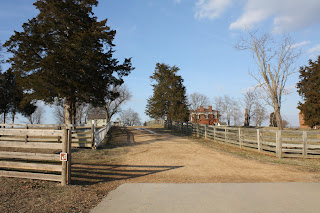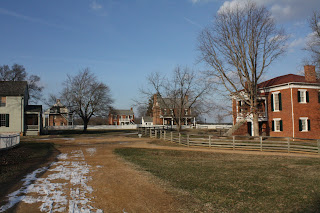Perhaps the most enticing part about moving all over the country every few years (or, in this case, every few months) is that you are constantly the tourist (which is extra lovely if you do enjoy being a tourist, as we do). I don't know that we have spent an entire weekend at home since we've been here. This past Saturday, with no visitors to welcome and no agenda on the books, we decided Appomattox was worth the drive. We decided this at 11:15 AM, while we were both still in our pajamas and Baby Blue was humming his way to his second nap of the day. By 11:30, we were packed and in the Prius, sleeping baby in the back before we ever hit I-95.
Of course I have pictures...which I have narrowed down from 328 for your viewing pleasure. And a list of the top 5 new facts I learned on our trip. Pay attention...I am about to give you all the answers to a someday Jeopardy category titled "The Men of Appomattox" (or perhaps "History Made in Houses").
The drive over is through many small towns that all saw battle in the last days leading up to the surrender at Appomattox. With Lee and his army marching in one way and Grant and his army marching in another, each trying to forecast the opponent's next move, they ultimately met up along the Richmond-Lynchburg Stage Road.
Fact #1 Appomattox wasn't a destination for surrender...it was where the wide open road was blocked by scores of Union soldiers.
Overheard in our car on the way there:
Neal: Doesn't it seem odd that they would choose this place to surrender? I mean it's in the middle of nowhere. What was the point of that?
Ally: I haven't a clue. Maybe the other court houses were booked that day?
As it turns out, General Lee found himself surrounded in the little town of Appomattox Court House with, literally, no way out. Not much you can do at that point besides give up.
Coming up from the parking lot of Appomattox Court House National Park, you are greeted with thousands of acres of land, where the last battles were fought, and these rows of fences, indicating the outlines of a village.
Cresting over the hill, the town of Appomattox Court House is laid out before you. Nearly all of the buildings are original, with the tiny exception of the 2 most important ones. The red brick building in the far right of the photo is the actual court house.
Fact #2 Nothing was signed and no surrender was made at the actual court house. There is all kinds of confusion because Lee surrendered at Appomattox Court House, except that's the name of the town, not the building where the event occurred. So pretty as it is over there on the right with its symmetrical windows and front porch, it was not chosen for the meeting because it represented government...and if you know a thing or 2 about rebels, they generally don't choose government buildings for any kind of meeting. (Also...yay for snow, as fleeting as it may be. There was a serious lack of that down in Georgia.)
The road that intersects with the one I was standing on for this picture is the Richmond-Lynchburg Stage Road. This is where Lee found himself surrounded and where the "stacking of arms" took place after the terms were agreed upon. NPS guides really know how to tug on the historical heartstrings when they say things like, "you are literally walking in their footsteps right now." All ya gotta do is reel me in...I just make this check out to the National Park Service?
The spork in the road.
To the left is Meeks General Store (original), then clockwise is Clover Hill Tavern guesthouse (original), Clover Hill Tavern kitchen (original, now the bookstore and where you can get your National Parks Passport stamped if you are part of our Nerd Herd), and Clover Hill Tavern. The original name of the town, Clover Hill (yes, I know...shocker) was due to life being centered around the tavern. I got in trouble the last time my life was centered around the tavern. Clearly I am from another age. (Just out of the frame to the right is the court house, which was reconstructed after a fire destroyed it post-surrender. AKA not walking in their actual footsteps.)
The Appomattox Court House, where, on April 9, 1865 absolutely nothing happened.
Fact #3 The actual surrender took place at local businessman, Wilmer McLean's house because it represented neutral territory. Also, Mr. McLean was the first person General Lee's aide-de-camp met in the street that morning.
Somehow, in the hustle and bustle of trying to park a stroller and catch up to the rest of the group, I forgot to take a picture of the front of McLean's house. But it is your typical 2-story brick with stairs to the front door. (sidenote: I'm not terribly sure this part of the park is handicap accessible. They weren't jumping at the chance to offer us an elevator or a ramp for the stroller.)
As they say, this is where it all went down. General Lee and his aide met with General Grant and practically his entire staff (including, as it turns out, President Lincoln's son, Robert). Very few of the furnishings in this room are original as a) General Grant "bought" the table and chairs (or "stole" as Mr. McLean would later tell it) and b) the original McLean house was dismantled entirely by profiteers in a scheme to transport it to DC and open a Civil War museum. The house was never moved and the pile of brick and lumber disappeared over time. This house is a re-creation by the NPS. Again, not actual footsteps.
Although this couch is said to have the butt-print of Robert Lincoln. So...original. But totally roped off.
These are parole passes. Which bring us to...
Fact #4 General Grant's terms for surrender were only that the rebel soldiers no longer took up weapons against the country. General Lee's terms were that his men could return home to their families without facing trial for treason or prison.
General Lee had 30,000 troops with him at the time of surrender. They brought in 2 printing presses and worked all night to get passes printed for everyone by the next day. Which begs the question...why do we have to wait for weeks and weeks to get our orders for the next duty station? Something has gone way off track with our efficiency.
The entire event was an exercise in honor. Honor answering honor is what the 2 commanders called it. During the stacking of the arms, Union troops saluted Confederate troops, who saluted back. And Confederate troops were allowed to keep their sidearm. Enlisted men were allowed to keep their horse, if they had one. The parole passes provided safe passage for Confederate soldiers to return home and even afforded them free lodging and food in Union-supported establishments. But it also proved that they were not deserters, who did face trial and prison.
And lastly...
Fact #5 The surrender at Appomattox is generally only a blip on someone's radar, usually around the 6th grade. But being there, hearing the stories, and understanding what lead to the event and what groundwork it was laying for the future is much more vivid when you visit the park. It is easy now, over 100 years down the road, to forget about what was at stake and how the Civil War was anything but civil. Men and women fought and died over the idea that we are all equal...that no one can own another person. The civil war over civil rights. And today we do battle for civil rights in courthouses and in the media and on our Facebook pages and through protests. The Appomattox Court House motto is "where the country was reunited." And we giggled because maybe we were. But it didn't stick. We are a country divided today, and I would argue even more so than in the days leading up to 9 April, 1865.







Super-di-duper cool!! Thank you for sharing that with us!
ReplyDeleteLove it! I will have to share this one with Tebo. He is a huge history buff! :)
ReplyDeleteI have a feeling Kelsey would be all over this litttle treck, especially since he found out he could tour the house in Savannah where Sherman had his office and Kelsey said he'd "just die" if he could go in. Yikes. ENjoy the area!!
ReplyDeleteIts so nice to see how much you all are. enjoying the area. So many folks aren't very interested in history, but it sure gives context,doesn't. it? Couldn't agree more about our current un-reunited status.
ReplyDelete